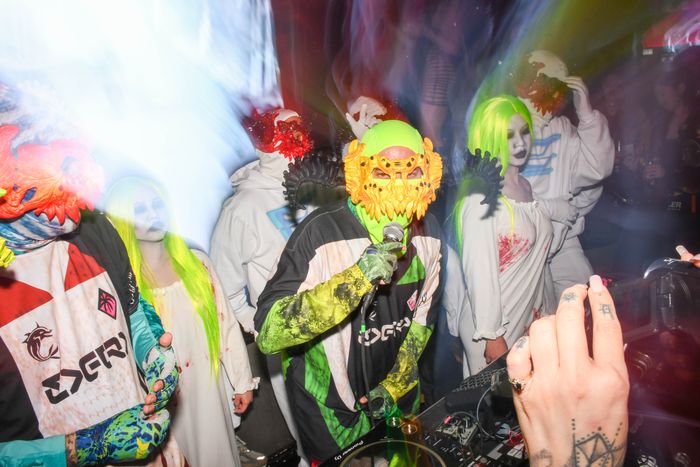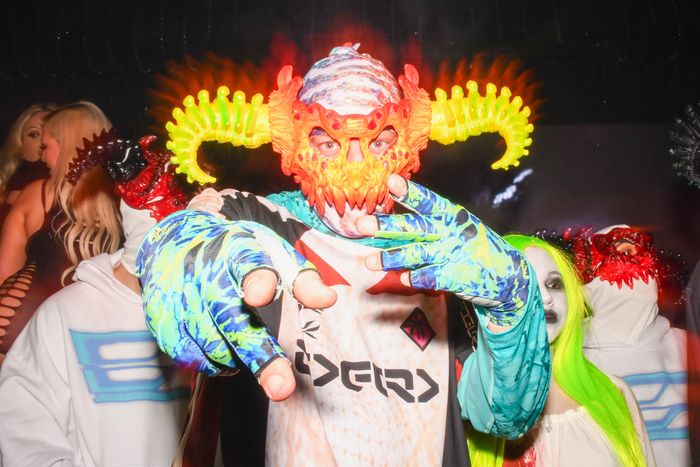
At the commencement to this year’s awards season, just before Labor Day, writer-director Harmony Korine’s experimental action flick Aggro Dr1ft premiered at the Venice Film Festival to a ten-minute standing ovation; the foremost auteur of weirdo white-boy fuckery did a happy dance as chants of “Harmony, Harmony” rang out through the Palazzo del Cinema auditorium. At the second night of the Los Angeles premiere of Aggro Dr1ft last week, however, Korine received a different but no less appreciative reception. Stepping behind a mixing board at Hollywood’s Crazy Girls topless nightclub to “DJ” — or at least twiddle some knobs while a bombastic mix of baile funk, trap, and metal played, punctuated by the recorded sound of gunshots — the filmmaker was showered with dollar bills by fans and flanked by scantily clad exotic dancers on a stage. Korine’s glee was only partially hidden behind the goofy 3-D printed demon-horned mask that has now become his trademark look.
Aggro Dr1ft is what Korine describes as a “post-movie non-film,” starring Spanish actor Jordi Mollà as BO, the self-professed “world’s greatest assassin,” and featuring an extended cameo by Travis Scott as his Bible-reading, blunt-smoking protégé Zion. The movie has so far polarized critics, with some reviewers decrying Aggro Dr1ft’s “vibes over substance,” video-game-informed aesthetic, and baffling dialogue (“Kill, kill, dance bitches,” etc.). Conversely, Slant praised Aggro Dr1ft for its “perfect cinematic representation of our current media landscape” and how it adapts “to our current brain rot from being terminally online.” Deadline complimented it too, sort of: “[It’s] rare to see something so pure and aesthetically relentless, with no other intention than to get inside your head. If you let it in, it will be there forever and ever, for better or worse.”
To anyone even mildly aware of Korine’s career fascination with societal decay and sexual titillation, his choice to unveil new work amid drifts of blunt smoke in a nontraditional venue full of twerking limbs came as less than a shock. Around 400 viewers took in the spectacle of his multivalent film (which was shot with NASA-engineered infrared cameras, then spruced up in postproduction with all manner of AI and otherworldly VFX) on ten smallish screens throughout the club as lingerie-clad servers sashayed through the crowd providing cocktails. The 51-year-old filmmaker emerged from the backstage area accompanied by a retinue of masked little people wielding toy machine guns, a trio of unnervingly poe-faced young women with neon wigs and corpselike makeup, hype men in sweatsuits and demon masks, and a full complement of strippers — the latter a kind of IRL corollary to Aggro Dr1ft’s scenes featuring pole dancers with fireworks shooting out of their genitalia.
Korine is the “scuzz poet” behind such filmic provocations as 2013’s teensploitation fever dream Spring Breakers and Fight Harm, an abandoned comedy vérité in which the director, apparently inebriated, was filmed goading passersby into punching him out. But Aggro Dr1ft’s back-to-back strip-club premieres aren’t just Korine-brand transgressive deviance for deviance’s sake. They functioned as a coming-out party/research-and-development run for his new, private-equity-backed content factory EDGLRD, which produced Aggro Dr1ft ahead of a suite of yet-to-be-announced content initiatives. The director’s last conventional movie effort, The Beach Bum, took in a mere $4.5 million worldwide. And in implicit recognition of the dwindling market share for the independent-minded cinema Korine favors, EDGLRD is attempting to tap revenue streams outside of simple ticket sales by harnessing the power of other cultural worlds Korine has straddled: skateboarding, fine art, video games, and underground youth gone wild.
Despite his fluency with trailer-park dishabille, the filmmaker is a practicing fine artist. He’s long been represented by the blue-chip megagallery Gagosian, which earlier this year exhibited acid-hued paintings with imagery drawn from Aggro Dr1ft at the Los Angeles outpost of the gallery Hauser & Wirth. At Crazy Girls, EDGLRD drafted off that notoriety, selling skateboard decks showcasing otherworldly images from the movie for $100: a commodification of boards as art objects first innovated by the fashion brand Supreme, which has released boards by art superstars including Jeff Koons, Takashi Murakami, Damien Hirst, and Marilyn Minter.
Moreover, to hear it from EDGLRD’s head of film strategy Eric Kohn, taking notes from Supreme’s business model — which creates artificial scarcity by releasing clothing in “drops” and has branded itself around skateboarding and graffiti outlaw subcultures to a multibillion-dollar valuation and CFDA-sanctified respectability — is more important to EDGLRD than courting Hollywood.
Help me understand Harmony’s ambitions with screening Aggro Dr1ft this way and how they fit into your overall strategy with the company.
The economic pressures on a film to perform at the box office are probably the biggest hurdle to creativity in the film community right now. Because there’s a ceiling to how much success you can have with a bold, risk-taking work of art if your metrics are only tied to box office and streaming models for distribution. If you look at other markets related to art — whether that’s fine art or fashion or skateboards, all these different areas that we’re playing in — there’s much more stability because they’re scaled accordingly.
The way this company is being built takes a lot of the economic pressure off of the movie so that it can perform in these other markets. With Aggro Dr1ft, there was an exhibit at Hauser & Wirth for months, just sitting there the way a billboard might be sitting for a movie. Except instead of paying for a billboard, the art was an extension of the Aggro Dr1ft experience itself.
As were the masks, which generated a lot of attention as they traveled across the festival circuit and are themselves a high-end fashion product that will be for sale very soon. So everything we are making, we’re creating in a way that is able to coexist holistically in all these different markets. We don’t feel like we have to make a traditional feature film that has to be responsive to whatever studios feel is bankable right now.
Is the movie going to ever get a traditional theatrical release or go to streaming?
The movie will be streaming in the near future. I can’t say when exactly, but the end goal is that anyone who wants to see Aggro Dr1ft is going to be able to. And just like a traditional theatrical release these days is engineered to help drive awareness for the streaming outcome, we are hoping that people who are not able to go to the special events that we are creating for this film will also get the chance to see it when it’s available that way.
Over the weekend, we hosted three screenings of the film at the American Cinematheque. That’s not part of the EDGLRD experience, but obviously it’s a way for us to open the door to the traditional moviegoing audience that still shows up for a Harmony Korine film. We are going to continue doing that, scaling up or down with those screenings as we travel around with the film. Not every city we hit is going to have the same kind of theatrical experience. But one of the things that’s really core to the approach we’re taking is that it allows a lot of flexibility and experimentation. So if something seems like it’s working, we’ll do more of it. And if it doesn’t, we’ll do less.
So having the director go around the world doing DJ sets to popularize his movie isn’t your business model, per se.
We have scarcity on our side. We don’t have to do this too many times to feel like we’re having a real impact because getting in that room is a one-of-a-kind experience. We don’t know exactly how many cities we’re going to hit this way, but certainly having someone who’s a true performing artist and — I think you could tell from that room — having a great time is a great asset. You’re not going to have that with every filmmaker.
We’ve been sort of building up to this point where there’s full confidence with the team, and that includes Harmony, that we can pull off this live performance. He’s all in. This is a key part of what we’re doing here. It’s not just to create a movie. It’s to create an experience and take it on the road.
So why show Aggro Dr1ft at a strip club?
First of all, we have a transgressive artist at the top of the company whose entire career for over three decades has been about pushing people past a certain degree of comfort and familiarity into real spaces that are underrepresented in popular culture. You’ve seen that since Kids and Gummo, truly. So the idea was getting a bunch of cinephiles and other people who wouldn’t proudly announce that they’re going to a strip club into this sort of taboo environment. To turn it into a public event space is very much consistent with the kind of creative identity that Harmony has cultivated for himself.
There’s another element on top of this, which is that from an exhibition standpoint, I think it’s really important to be thinking expansively about how people choose to go out and spend their time. Going to a movie theater is a very limited experience. Going to a movie experience in a place that you’ve never been before is something else. It gets people talking. And so we’re not only going to strip clubs with this movie. But the idea of going to a strip club — we’re figuring out if we could pull it off.
Does it matter that staging the event at a strip club might cater to men more than women?
First of all, I saw a lot of women there who seemed to be having a good time. Harmony has a pretty dedicated female audience. So I don’t know. The life cycle of Harmony’s movies has often been about upending expectations. And strip clubs aren’t only for men. I don’t know if it’s necessarily limiting the potential in that respect. But again, this isn’t the only way you can see the movie. Anyone who’s uncomfortable with this particular opportunity, we’ve created other ways they can have this experience too.
EDGLRD has a skateboard team. And there was skateboarding footage that screened behind Aggro Dr1ft soundtrack composer Araabmuzik as he DJed early in the evening at Crazy Girls. What part does skateboarding play in the company’s ambitions? How has Supreme informed what you do?
Harmony’s been tied into that community, into Supreme, his entire life. He came up with a lot of amazing skaters that helped define the art form associated with skating. He knows a lot about the medium of the skateboard video and was very inspired by that in his own work. So, in that sense, the skater element is foundational to the company’s identity — as is its legacy to Supreme. In a certain way, we’re indebted to that model more than any traditional film studio or entertainment studio more generally.
Please explain.
We have a really promising skate team headed right now by Sean Pablo, maybe one of the best skaters in recent history.
What you saw on those screens was point-cloud footage of skaters from an upcoming video that we’re working on. There is a discreet star system around the skateboard community that has only accelerated with social media. But the skateboard-video form has not really changed that much in a couple of decades. And so with the kind of VFX and animation resources that we have at our company, we’re looking to shake up that form and really create something for the next generation of skateboard consumers. It feels like it’s overdue.
In terms of merch, I saw people leaving the event with three, four skateboard decks. At $100 each, that’s a decent revenue stream.
We’re a product-led company first and foremost. The masks are also a part of this. You saw the movie: There’s a demon, and the character model for the demon was then applied to a 3-D printer that created the mask. So it wasn’t like we adapted merchandise from the movie after there was some existing fandom. The creative process created both a product from the movie and the movie itself. So everything that we’re working on is going to have that kind of approach.
You guys are also planning to do video games. So what is the simplest way to describe EDGLRD?
The simplest way to describe it is to say we are a multimedia design collective. We make wearable merchandise and other materials associated with our entertainment. And we create proprietary technology that helps us make that entertainment.







